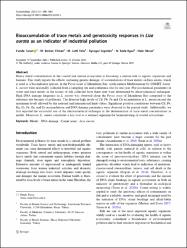Bioaccumulation of trace metals and genotoxicity responses in Liza aurata as an indicator of industrial pollution

Göster/
Tarih
2022Yazar
Turan, FundaYılmaz, M. Bertan
Yola, Mehmet Lütfi
Ergenler, Aysegül
Ilgaz, Nermin Seda
Öksüz, Hale
Üst veri
Tüm öğe kaydını gösterKünye
Turan, F., Yilmaz, M. B., Yola, M. L., Ergenler, A., Ilgaz, N. S., & Oksuz, H. (2022). Bioaccumulation of trace metals and genotoxicity responses in Liza aurata as an indicator of industrial pollution. Ecotoxicology (London, England), 31(9), 1390–1402. https://doi.org/10.1007/s10646-022-02591-xÖzet
Heavy metal contamination in the coastal and marine ecosystems is becoming a serious risk to aquatic organisms and humans. This study reports the effects, including genetic damage, of accumulations of trace metals on Liza aurata, which is used as a bio-indicator species, in the Payas coast of Iskenderun Bay, north-eastern Mediterranean by COMET Assay. L. aurata were seasonally collected from a sampling site and a reference site for one year. Physicochemical parameters in water and trace metals in the tissues of fish collected from these sites were determined by electrochemical techniques. High DNA damage frequency in L. aurata was observed along the Payas coast of Iskenderun Bay compared to the reference site because of pollutants. The detected high levels of Cd, Pb, Fe and Cu accumulation in L. aurata exceed the maximum levels allowed by the national and international limit values. Significant positive correlations between Cd, Pb, Hg, Cr, Fe, Zn, and Cu accumulations and DNA damage parameters were observed in the present study. Additionally, we first reported the successful use of the electrochemical technique in the determination of trace metal concentrations in mullet. Moreover, L. aurata constitutes a key tool as a sentinel organism for biomonitoring of coastal ecosystems.















